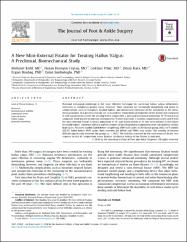| dc.contributor.author | Erdil, Mehmet | |
| dc.contributor.author | Ceylan, Hasan Hüseyin | |
| dc.contributor.author | Polat, Gökhan | |
| dc.contributor.author | Kara, Deniz | |
| dc.contributor.author | Bozdağ, Ergün | |
| dc.contributor.author | Sünbüloğlu, Emin | |
| dc.date.accessioned | 10.07.201910:49:13 | |
| dc.date.accessioned | 2019-07-10T19:58:11Z | |
| dc.date.available | 10.07.201910:49:13 | |
| dc.date.available | 2019-07-10T19:58:11Z | |
| dc.date.issued | 2016 | en_US |
| dc.identifier.citation | Erdil, M., Ceylan, H. H., Polat, G., Kara, D., Kara, D. ve Sünbüloğlu, E. (2016). A new mini-external fixator for treating hallux valgus: A preclinical, biomechanical study. Journal Of Foot & Ankle Surgery, 55(1), 35-38. https://dx.doi.org/10.1053/j.jfas.2015.04.018 | en_US |
| dc.identifier.issn | 1067-2516 | |
| dc.identifier.issn | 1542-2224 | |
| dc.identifier.uri | https://dx.doi.org/10.1053/j.jfas.2015.04.018 | |
| dc.identifier.uri | https://hdl.handle.net/20.500.12511/3123 | |
| dc.description | WOS: 000367071200010 | en_US |
| dc.description | PubMed ID: 26190777 | en_US |
| dc.description.abstract | Proximal metatarsal osteotomy is the most effective technique for correcting hallux valgus deformities, especially in metatarsus primus varus. However, these surgeries are technically demanding and prone to complications, such as nonunion, implant failure, and unexpected extension of the osteotomy to the tarsometatarsal joint. In a preclinical study, we evaluated the biomechanical properties of the fixator and compared it with compression screws for treating hallux valgus with a proximal metatarsal osteotomy. Of 18 metatarsal composite bone models proximally osteotomized, 9 were fixed with a headless compression screw and 9 with the mini-external fixator. A dorsal angulation of 10 degrees and displacement of 10 mm were defined as the failure threshold values. Construct stiffness and the amount of interfragmentary angulation were calculated at various load cycles. All screw models failed before completing 1000 load cycles. In the fixator group, only 2 of 9 models (22.2%) failed before 1000 cycles, both between the 600th and 700th load cycles. The stability of fixation differed significantly between the groups (p < .001). The stability provided by the mini-external fixator was superior to that of compression screw fixation. Additional testing of the fixator is indicated. | en_US |
| dc.description.sponsorship | Bezmialem Vakif University, Scientific Research Projects Department [9.2012/8] | en_US |
| dc.description.sponsorship | The present study was funded by Bezmialem Vakif University, Scientific Research Projects Department (grant 9.2012/8). | en_US |
| dc.language.iso | eng | en_US |
| dc.publisher | Elsevier Science Inc | en_US |
| dc.rights | info:eu-repo/semantics/embargoedAccess | en_US |
| dc.subject | Biomechanical Stability | en_US |
| dc.subject | Cannulated Screw | en_US |
| dc.subject | External Fixator | en_US |
| dc.subject | Hallux Valgus | en_US |
| dc.subject | Proximal Osteotomy | en_US |
| dc.title | A new mini-external fixator for treating hallux valgus: A preclinical, biomechanical study | en_US |
| dc.type | article | en_US |
| dc.relation.ispartof | Journal Of Foot & Ankle Surgery | en_US |
| dc.department | İstanbul Medipol Üniversitesi, Tıp Fakültesi, Cerrahi Tıp Bilimleri Bölümü, Ortopedi ve Travmatoloji Ana Bilim Dalı | en_US |
| dc.authorid | 0000-0001-6742-8464 | en_US |
| dc.identifier.volume | 55 | en_US |
| dc.identifier.issue | 1 | en_US |
| dc.identifier.startpage | 35 | en_US |
| dc.identifier.endpage | 38 | en_US |
| dc.relation.publicationcategory | Makale - Uluslararası Hakemli Dergi - Kurum Öğretim Elemanı | en_US |
| dc.identifier.doi | 10.1053/j.jfas.2015.04.018 | en_US |
| dc.identifier.wosquality | Q4 | en_US |
| dc.identifier.scopusquality | Q2 | en_US |


















